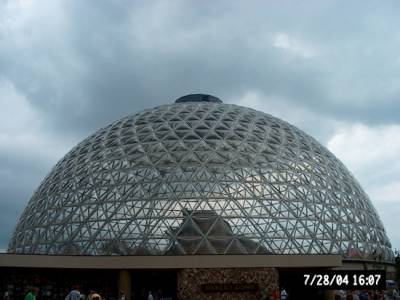
In 1947, the American architect Richard Buckminster Fuller proposed a new concept in architecture, a hemispherical dome made of metal supporting structures in the form of honeycombs, with a plastic film of special polymer stretched over metal cells, so-called. "Geodesic dome".
Geodesic dome, light transparent design capable of protecting from wind and rain, but at the same time able to cover a fairly large area and having a large internal volume. The Fuller Domes, strikingly different from the usual buildings, light and transparent, they seem futuristic buildings, compared with the usual stone houses or metal buildings.
Bearing skeleton of domes is made of light metal beams, as a rule, steel.
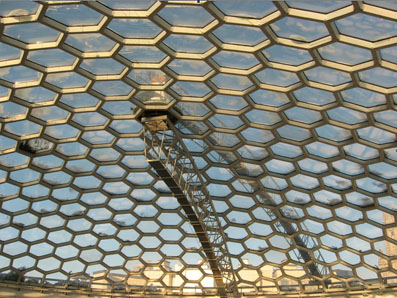
A typical geodetic dome has the shape of a hemisphere, which allows to distribute the load evenly and gives the domes a good streamline. The cells of the frame are hexagonal, with a number of pentahedral elements that contribute to a smooth convergence of the structure to the center of the hemisphere.
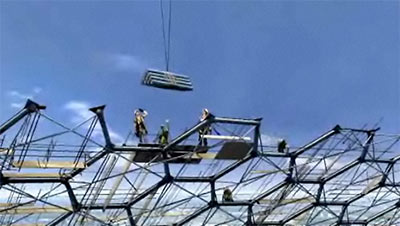
In the cells are inserted light metal frames, on which a plastic film of a special polymer is stretched, "Polyethylene terefluoroethylene", a copolymer of polyethylene and tetrafluoropolyethylene, "Ftoroplast" from which a non-stick coating is made for frying pans. Polyethylenetetrafluoroethylene - "ETFE" combines the basic properties of polyethylene and fluoroplastic, it is a durable and elastic plastic, non-flammable, heat resistant, not decomposable and having a dirt-dust repellent surface capable of self-cleaning. Unlike polyethylene, ETFE does not harden and does not crack in the frost.
The film lining of the domes is strong enough to withstand any wind, up to the hurricane, it can withstand the weight of a person. When the scraps are damaged, the films slowly fall to the bottom, like a conventional polyethylene film; in case of fire, ETFE does not form hot melted droplets, like polyethylene.
Fuller's cupolas are not widely used in architecture, but they are used in the design of some buildings of innovative design that have received a reputation for new architectural wonders, such as:
The dome Klimatron, built in St. Louis in 1960, with a diameter of 53 meters, made of aluminum bearing frames, serving to create a microclimate in the greenhouse.
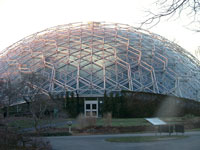
The dome is "Millennium", "Millennium", created in 1999 in English "Greenwich", which has 50 meters in height and 320 meters in diameter, with a complex system of supporting cables.
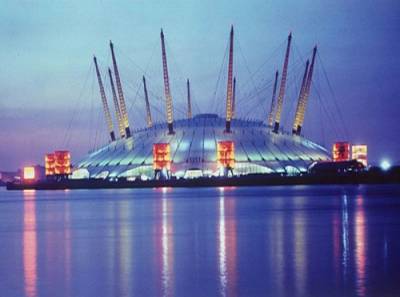
Botanical Garden - "Eden", in the form of a series of domes, built in 2002 in England, in the vicinity of Cornwall.

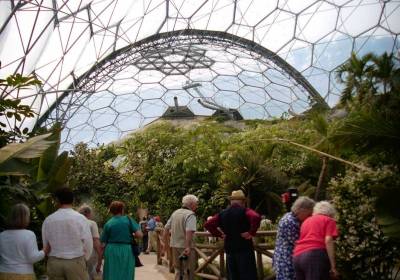
The building of the national Beijing swimming complex in China. Built in the shape of a square of asymmetric supporting cells, 30 meters high and 170 meters long, nicknamed the "Water Cube" due to its geometry.
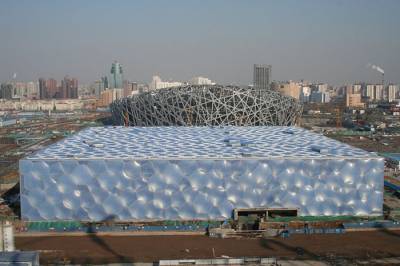
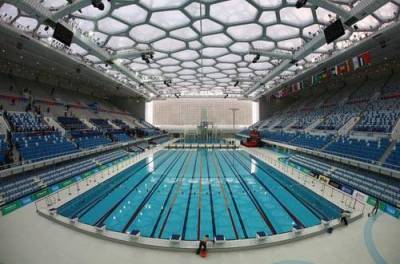
These are only some architectural structures with the use of a geodetic dome, which received the glory of new architectural wonders.
But the most impressive project, involving the construction of a dome over the center of Houston, was suggested by the inventor of geodesic domes.
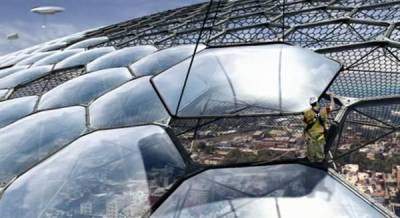
dome over Houston, involves the creation of a giant dome half a kilometer high, 1600 meters in diameter and a total area of 6.5 square kilometers. This "Mega-Armament" aims to protect the city center from constant hurricanes, seasonal rains, summer heat and in general make life in the city more comfortable, regardless of the vagaries of the weather.
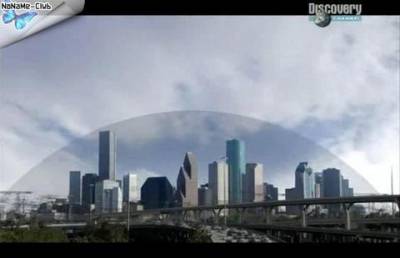
According to the author of the project, the dome over Houston should pay off over time due to lower costs for public services, cleaning the streets and heating. If such a project can be claimed in the relatively prosperous climatic zone of the United States, then it should be more in demand in the northern latitudes, where protection from winter frosts and snowfalls, suffocating summer heat, mosquitoes and seasonal rains is a vital necessity.
Such a project - "Cities under a dome" may seem fantastic at first sight, but there is nothing fantastic in the technical details of the domes, which has been proved many times at different structures in which the geodesic dome was used. The construction of domes is technically feasible, it's far from the most complicated and not the most expensive constructions. The idea to close an entire city or district with a giant dome gives the impression of a "Megaproject", because of the scale of the construction, rather than the technical difficulties or the cost of its implementation.
The idea of "Cities under the dome" can be made more realizable if one uses instead of giant domes of kilometer diameter, a set of relatively small hemispheres, with a diameter of hundreds or tens of meters, covering small building sites, or individual buildings.
But even more convenient from the point of view of practical expediency can be the concept of the so-called. "Dome system", consisting of long arched constructions covering individual houses, and hemispheres that communicate with each other from the inside and form a single complex to maintain the microclimate, similar to a giant greenhouse.
Arched constructions and small hemispheres covering individual buildings are much easier to build than large domes that can close groups of houses together with yards and adjoining areas. Small structures of dome systems will be easier to install, as special cranes or helicopters will not be needed, and they allow more rational use of the internal space of domes covering only the useful area.
Unlike the classical hemispheres, the only supporting element for which is its own skeleton, the skeletons of the dome system can be equipped with internal supporting structures, the support for which is the building covered by the dome. Such a skeleton will make the dome more rigid and remove a significant part of the load from the outer mesh shell, which will make it possible to make it from a serial profile that is cheap and widely available.
Standard cells with three layers of dome film have sufficiently high heat-shielding properties, comparable to three-layer plastic double-glazed windows. But for the north they can be strengthened with several additional layers of film, up to ten layers. In order to avoid the large expense of an expensive ETFE film, only outer layers can be made from the standard strong ethylene fluorethylene film, the inner layers not exposed to wind may also be a cheap thin film, both fluoroplastic and other polymers. The thermal insulation properties of multi-layer panels are comparable to concrete slabs or a layer of insulation, allowing to keep the heat even in severe frosts.
The dome system offers great advantages in terms of keeping heat in winter, allowing several times to reduce energy consumption and efficiently use alternative heat sources.
The main advantage of the dome system in terms of thermal energy savings is the ability to effectively use the so-called "Low Potential Heat Sources". Sources of heat with a low temperature, low energy potential, as a rule, are lost, uselessly dissipating in space. Because of the low potential, they are not beneficial to use in standard heating systems. In standard heating systems, a high temperature is required, otherwise it will not be profitable to pump the coolant through the system. To maintain the microclimate in the domes, it is sufficient to have a coolant with room temperature or even zero, such as river water.
In addition to the fact that the domes themselves can serve as an additional heat insulator, keeping the heat from the houses, they also provide an opportunity to use low potential sources profitably, preventing the useless loss of energy in "Heating the atmosphere" and using the heat "By the second circle" due to heat exchangers .
The dome allows not only to save heat from artificial sources more economically, but also to delay the heat received from the sun, due to the "Micro greenhouse effect", which can create a special coating on the inside of the plastic film, reflecting the thermal, infrared radiation back under the dome, but without hindrance transmissive sunlight.
Under the standard scheme of heat supply, the houses are heated with hot water, energy received from the coolant dissipates in the atmosphere through walls and windows and leaves with warm air through the ventilation system. Domes form an additional barrier that keeps heat inside leaving through the walls, and allows to return the heat spent for heating the air due to heat exchangers. Passing through regenerative heat exchangers - "Recuperators", warm air from ventilation and from under the dome gives its heat to fresh atmospheric air entering the ventilation system, creating a closed thermal cycle minimizing energy loss.
Under the dome, you can also send low potential heat from other sources. Boilers and industrial enterprises allocate a lot of heat, which is too scattered for heat supply systems, but it can be sent under the dome. How much energy is lost in the form of hot smoke from the boiler pipes? One heat recuperation "Out of the pipe" is enough to heat the nearest houses. How much heat can industrial enterprises, located on the periphery of cities, provide? And the heat from the numerous food outlets and bakeries located in the city? They use powerful furnaces, but the heat from them is mostly dispelled in the atmosphere. How much fuel can be saved by sending scattered heat from all available sources to the domes?
Recuperation of low potential heat allows to use even heat from running water in winter, the potential of which is completely unsuitable for standard heating, but it is enough for domes. In winter, water from natural water bodies has a temperature close to zero, but when this water freezes out, a large amount of thermal energy is released, which allows heating the air to zero temperature. The water becomes a liquid suspension of small ice - "Shugu". In winter, in cold weather, zero-temperature air is quite suitable for creating a microclimate under domes. And to heat the air from zero temperature to room temperature, it is much easier than from minus dozens of degrees, during winter frosts. Using running water in winter, it is possible to save two to three times the fuel due to a practically free source of heat.
Traditional heat networks do not allow full use of the domes, due to the fact that the heat supply systems are designed only for high-potential heat. And the heat from low potential sources will be able to heat only the nearest buildings, it is difficult to move warm air in the dome system over long distances.
But this disadvantage can be eliminated in the design of northern cities, specifically from the calculation of the dome system, which makes it possible to use as a centralized heat supply not pipes, and channels with water.
On the northern land there are many rivers, and most of the cities are on the banks of rivers or near large creeks. When designing "From scratch", you can select places with suitable sources of running water. The abundance of running water allows us, as the main heat of the distribution system, to use a network of underground canals, similar to storm sewerage, associated with heat and power plants and powerful industrial heat sources. Water has a large heat capacity and, with a suitable terrain, can flow spontaneously, without energy, and over long distances. Channels, in contrast to pipes, have a high throughput, a large volume of coolant allows to reduce its minimum required temperature, up to room temperature. The heat can be extracted from the channels through a recuperation system separate for each house and sent to the apartments through an external, water or air distribution network. That reduces to zero the risks of calcareous deposits in the pipe system or the flooding of apartments, with the use of warm air, energy consumption will also be significantly reduced, since heated air will flow to the upper floors by gravity.
If we design the city in such a way that the system of heat distribution channels passes first through the main industrial enterprises, getting from them the scattered heat accumulated under the domes through the recuperators, and then optionally heated by heat from the main city heat of electric power stations, it is possible to minimize heating costs in winter.
In addition, the system of heat distribution channels, allows you to use fundamentally new sources of heating, biological heat sources.
Microorganisms that feed on biomass, in the form of an aqueous suspension, release a large amount of the body. The same amount of heat can be obtained by burning the same organic mass in boiler rooms, but "Biological combustion" is more convenient in many ways. Only dry and high-calorific fuel can be used in boiler houses, for example, wood burns well, but not all types of organic fuel are well suited for burning. First, boiler fuel should be low in water, it must be dried, the cost of thermal energy for drying reduces the overall efficiency. Secondly, not all types of organic fuel can be dried and burn well even in the dried state. For example, food waste will have a low combustion temperature, even dried, although it is difficult to dry them and almost all the energy received from such fuel will go away its drying. In the boiler rooms, the heat losses are great, especially when using a fuel with a low combustion temperature, in biofuel it is usually not high. When burning garbage in boiler houses a lot of highly toxic substances are released, which makes the use of this type of fuel dangerous and expensive.
With the biological combustion of biofuel - "Metabolisation" it is impossible to get a high temperature, but this defect is reduced to zero when taking heat through the channel system. In all other respects only advantages. The fuel does not need to be dried, you can use raw natural raw materials, for example, needles, foliage, wood and agricultural waste. It is possible to use garbage and food waste, without preliminary processing and without the formation of toxic products, respectively, and without the cost of decontamination. Metabolisation of organic substances takes place in two stages, the first - "Anaerobic decomposition", or fermentation, which goes without access of air, with the formation of combustible gas, methane, methane can be used as fuel for power plants and power generators. The second is "Aerobic decomposition", which requires forced air supply, but gives a lot of heat. The temperature, which gives the vital activity of microorganisms, 35 - 40 degrees Celsius, is sufficient for heating water in heat distribution channels.
Heat generation by means of metabolism makes it possible to use raw biomass food waste and domestic garbage, with high efficiency. Heat generators can serve as urban wastewater treatment plants, which cleanse sewage in the summer, and in winter turn into heat generators. "Fuel" can serve as garbage and waste, accumulated in the summer at intermediate ranges, various types of biological raw materials. Together with special organic fuel, biological heat generators can "Burn and drain sewage". Il, obtained as the final product of biodegradation, can be used as a fertilizer.
The system of heat distribution channels can coexist with the system of channels with cold water, which in winter can be used to preheat the air to zero temperature. In the summer, channels with cold water can serve as a natural centralized air conditioner, reducing the temperature of the air in the dome system on hot days. That will allow maintaining a favorable microclimate in the system of domes at any time of the year and in any weather.
From the point of view of economic expediency, dome systems can not only pay for itself by reducing the cost of heating, but also save on construction. The microclimate created by the domes saves residential houses from the effects of wind, rain and severe temperature changes. That allows building under the domes of a light-weight building, the basis of which is not heavy building materials such as concrete and brick, and light frames made of metal and concrete beams trimmed with three-layer panels that are not carrying but light and cheap. Buildings from the "Sandwich" panels on metal frames are one of the new directions in construction, such houses are cheap and quickly built. Lightweight panels, despite their light weight, have good heat-insulating properties. Domes practically exclude water from entering into joints between panels and temperature differences, which can lead to destruction of external walls and corrosion of load-bearing beams, making buildings of light type not less durable than capital housing. Panel buildings are several times cheaper than concrete ones, at the same time the cost of the domes is not so great in comparison with houses. The cost per square meter of the series domes, usually within a few hundred dollars per square meter, is slightly compared to the prices for housing, the cost of arched domes will be even lower, since their cells have a simpler geometry and can be made from cheap materials. One of the standard domes of suitable dimensions has a diameter of 50 meters internal area, about 1900 meters and a cost of 50,000 euros, which in terms of square meter is about 25 euros. In a similar dome on a residential house, the cost of a meter will be several times higher, since the height of the dome will be larger, and the area covered is smaller. But all the same it is possible, it is possible to say with certainty that the relative cost of the domes is not great and with the massive development of this technology it will decrease several times more. With some risk of being dependent on the microclimate of the dome, interior buildings can be made altogether from some finishing materials, which makes them vulnerable to severe damage to the dome, but it allows you to reduce the cost of building 5, 10 times, compared with traditional housing.
The technology of covering buildings with domes must first go through the stage of incubation on the most investment-attractive buildings, such as shopping malls and office buildings, when it becomes spent and cheaper, domes will cover the residential buildings and production premises. Unlike Megaprojects, high cost and long-term payback, the gradual development of the concept of dome systems does not involve large expenditures and is designed for gradual development and standard financing.
In all likelihood, the technology of the domes will begin to develop not from covering entire buildings, but from the facades. Cover the dome of the building's facade is relatively inexpensive, at the same time, such a "one-sided dome", is convenient for visitors, giving shelter from the vagaries of weather, dirt and road noise. The construction of domes on the facades is closer to finishing, decorative works, but this is potentially the most popular direction from which the massive spread of domes can begin.
The most investment-attractive buildings designed for mass attraction of clients can be covered with domes entirely with adjacent territories, without half measures, or projected immediately on the basis of dome construction. Large domes can provide a large useful area with open space, they are aesthetic and at the same time relatively cheap. Dome structures are well suited for designing large shopping centers, such as the "Khan Shatyr" center in Astana: http://www.khanshatyr.com/
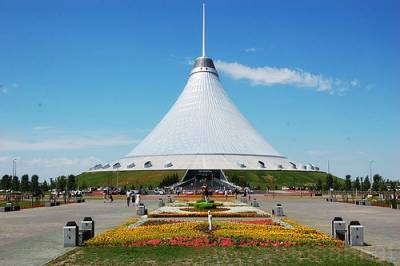
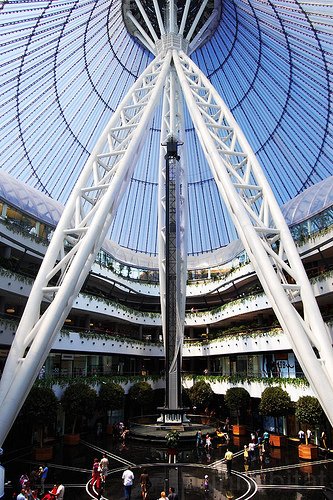
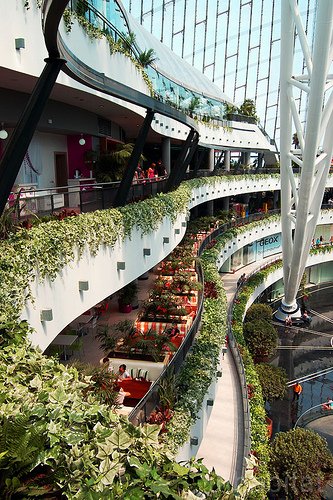
Dome constructions in the design of public buildings are known long before the invention of the geodesic dome, the central department store, which was still a covered market in tsarist Russia, many other buildings of covered markets and stations were designed for transparent domes giving a lot of light and interior space at moderate costs. The geodesic dome allows to continue this trend, minimizing heavy stone buildings.
After the technology of the domes has passed the stage of incubation in the rating buildings, it will become quite common and accessible for ordinary buildings. The use of dome systems in the north can be prompted by a reduction in fuel consumption for heating, on average, about 4 tons of fuel per year are spent per person, costing about a thousand dollars, the approximate price of a dome in terms of an apartment of several thousand dollars, the dome allows you to save up to 50% or more energy for heating. Domes should pay off for 5 - 7 years, at the expense of fuel economy, but this period may decrease due to new, more rational construction technologies.
Now domes have passed the first stage of incubation on experimental buildings, created more for novelty, than for practical use. The concept of the dome system makes the idea of covering cities with domes more accessible, realizable and investment attractive. Practical implementation of this concept can make northern cities an oasis of microclimate, akin to the evergreen garden "Eden" surrounded by blizzards and frosts.
Nikolay Agapov.
Discuss in forum: http://cosmosclub.forum2x2.ru/t3-topic#3
|








